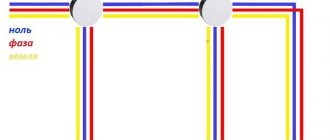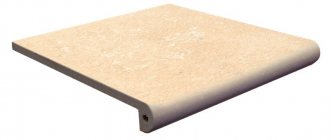Lawn grate for parking made of concrete
Unusual drainage coverings have begun to appear in parking lots, sidewalks, and parking lots on private property. Concrete grating is a product that allows you to combine functionality with environmental friendliness. This product is easy to use and easy to install. Such concrete structures are gaining wide popularity. They are often installed on lawn areas and eco-parking lots.
What are concrete gratings?
The decorative product is a stamped block of concrete. Stamping is done using casting or vibration pressing. Typically, the dimensions of a lawn structure are 60 by 40 by 10 centimeters. The concrete grid has several square or diamond-shaped holes. This lattice can protect the roots of plants. So, if lawn geogrids are exposed to external influences (transport, etc.), the grass will be able to recover immediately or after irrigation. Lawn geogrid performs several functions simultaneously:
- allows you to maintain the attractiveness of the lawn;
- helps make the lawn smooth;
- protects grass roots;
- strengthens the soil;
- warns floods.
The concrete structure is installed in the soil at a shallow depth. Drainage is laid under concrete geogrids, which protects the soil from excess moisture.
Why do you need a lawn grate?
Concrete lawn stones are strong and durable products made using semi-dry vibration pressing technology from high-quality concrete with high water resistance and frost resistance.
Paving the territory with cellular modules allows you to:
- hold soil on slopes;
- protect plant roots from stress;
- prevent water accumulation on the site;
- create comfortable conditions for walking and/or driving around the site.
One of the significant advantages of lawn gratings is the simple technology of laying them, which you can implement with your own hands.
Advantages and disadvantages
The lawn structure for eco-parking has many advantages that make the lattice stand out against the background of asphalt and tiles. Concrete used in the manufacture of geogrids is a good alternative to plastic modules. Such cells are stronger than their plastic counterparts. At the same time, the gratings can reliably protect the lawn: it will be preserved better than plants that were sown using traditional technology. Cars driving on the concrete support will not crush the grass, since it will be located in a niche.
Concrete geogrids have other advantages:
- grates allow rainwater to penetrate directly into the soil without interfering with plant growth;
- products are presented in different sizes and shapes of cells; in addition, it is possible to manufacture parking products according to sketches to order;
- During production, concrete mortar of different colors is used, so you can choose a shade that suits the landscape design;
- lawn or parking gratings are laid on sites; they can also become an alternative to conventional tiles, which are used for laying sidewalks.
The eco-parking structure is a universal product used in private and public areas, since its service life is at least twenty-five years. In addition, the color saturation of the cells does not disappear under the influence of ultraviolet radiation and precipitation - they remain bright for a long time. Products do not deteriorate due to the influence of low temperatures.
However, such structures also have their disadvantages that must be taken into account during installation. First of all, the material from which they are made does not allow the production of thin walls of the gratings, which often does not coincide with the architecture located nearby. It should also be taken into account that the installation of the slab material involves installation and fixation in the soil, which implies additional financial costs for the work.
Building materials are classified according to several main characteristics. We are talking about the shape and color of the gratings. In particular, the form depends on their purpose and happens:
- honeycomb-shaped (products can withstand loads of up to about twenty tons per square meter, so they are used when arranging sidewalks or bicycle paths, parking lots for cars and playgrounds for children);
- square (grids are intended for constructing areas where vehicle traffic is especially intense; they are able to withstand heavy loads - about four hundred tons per square meter).
The range of cell shades is varied. Products made using coloring pigment are sold at a higher price. The most popular shade is gray, since its cost in comparison with other products is minimal. The designs also come in red, brownish, yellow, green and blue.
Laying technology
Installation work of concrete products intended for eco-parking and other areas is more difficult to carry out than the installation of plastic cells. Experts explain this by the greater mass of building materials. Some sections are difficult to lift on your own. Otherwise, the building material must be laid in the same way as sidewalk tiles. To construct the cushion, builders use crushed stone and sand. To carry out the work, you will need a rubber mallet to install the product, a rammer, stakes, a cord and a building level.
Work must be carried out in the following order:
- First you need to prepare the site - make markings, hammer in pegs, weed the turf and make a small depression in the soil (thirty centimeters).
- Then you can level the bottom and check the depth using a level.
- After this, ten centimeters of crushed stone are poured. It should be watered and compacted well.
- A sand cushion (seven to ten centimeters) is placed on top, watered and compacted.
- Cell laying. The sections are carefully tapped with a mallet, setting them to the required depth. The depth is checked using a building level.
When installing the grate in a parking lot, you don’t have to maintain the slope, since water still does not accumulate on the surface of the structure. After completion of installation in the eco-parking area, experts recommend treating the surface with tamping equipment, then filling the cells with soil and planting plants.
Installation of lawn gratings - preparatory work
After constructing the pit you must:
- Compact the bottom and reinforce the walls with brick or stone masonry.
- Lay a cushion of crushed stone + sand or gravel + sand. The ratio of gravel (crushed stone) and sand is 4:1. Sand fills the voids between large grains of bulk material, which ensures the formation of a strong and dense preparatory layer after compaction.
- Lay a layer of geotextile that will protect the eco-parking area or paths from the germination of weeds. The geotextile should extend onto the walls of the pit, and its strips should overlap each other by 10-15 cm.
- Fill in the leveling sand layer, pour water on it, and tamp it down.
Areas of application
Eco-parking is far from the only place where such cells can be used. They are also indispensable in other conditions:
- A city where there is a special need for water drainage.
- In areas where there is a need to move liquid over a certain distance. In this case, such building material is the most practical and cheapest.
- Drainage of melt and rain water from roofs. Through the concrete grate, the liquid penetrates into the ditch and flows into the sewer.
- In areas fenced with concrete trays, where there is never waterlogging.
- In southern regions where areas need to be watered frequently, it is useful to have a good drainage system, since the flow of liquid will be controlled.
Return to contents
Application of concrete lawn gratings
Most often, lawn grates can be seen in parking lots, but this is not the only place where these structures are used. This is an excellent alternative to the usual emerald lawn - beautiful, but unsuitable for intensive use and loses its attractive appearance over time. The lawn grid allows you to get a lawn that is resistant to mechanical stress and has an impeccable appearance.
In country houses it is used to decorate the yard and to create a landscape garden. Large areas intended for public use are also equipped with lawn gratings. They protect plant roots and strengthen the soil.
The use of concrete lawn grates for parking.
Cottage owners use these concrete structures to equip:
- playgrounds, sports grounds;
- local areas;
- pedestrian paths;
- golf courses;
- parking for passenger vehicles.
In public places, such building material helps:
- Solve the problem of water flow and movement over a certain distance. Here, installing a lawn grate is the cheapest and most practical option.
- Drain water from roofs. It passes freely through the grate, then flows into the sewer.
Lawn grid modules are appropriate in areas enclosed by concrete trays, where waterlogging is completely excluded.
Laying lawn grating
In order to be able to park a car on the lawn or make a walking path, you need to use special lawn gratings. Lawn grass exposed to mechanical stress quickly gets trampled and loses its original appearance.
The lawn grate consists of modules made of plastic or concrete. This design serves to strengthen the soil and protect plant roots. The main purpose is to protect lawns in places of intensive use (parking lots, playgrounds, recreation areas, etc.).
Application of lawn gratings
Regardless of the type of lawn grating, they perform a common function - they provide stability and rigidity to the surface. The cells serve as containers for the root system of lawn grass or other plants. The block structure with locks provides coverage of an arbitrarily large area.
Garden trellises are made of concrete and polymer - recycled polyethylene. Massive cast concrete slabs with thick partitions are not always hidden in the grass; the mesh is visible. But they are cheaper, carry a greater load, and are suitable for installation under a cargo parking lot. Such blocks appeared much earlier than polymer ones.
Polymer lawn gratings are easier to transport and install, have different cell shapes, and are practically invisible in the grass.
Places of application of LDPE blocks:
- on golf courses;
- playgrounds in parks and local areas;
- in active recreation areas;
- in relief landscape design;
- pedestrian paths.
It is precisely these structures that do not disturb the natural landscape that are used to equip parking lots for passenger vehicles. If the car is technically in good working order, the grass crushed by the wheels will quickly recover.
Types of lawn gratings
A lawn lattice or mesh is made from concrete or durable plastic. Plastic grilles are most often used, as they are easier to install and look neater. Of course, like any other material, plastic and concrete have their own advantages and disadvantages.
Concrete lawn grate
A veteran of the market, it was with her that the history of strengthening lawns began. You can still find concrete tiles with cells from which grass grows in parks or parking lots. The main advantages of concrete gratings:
- Affordable price;
- High strength and durability;
- Modules can be of different shapes;
- No extensive preparatory work is required before installation;
- Increased drainage of rainwater.
Video: Ecological parking // FORUMHOUSE
The main disadvantage is that using a concrete lattice it is not possible to create a continuous carpet of grass.
It will look like an area with green grass and concrete islands. Therefore, this design is mainly used for installation in parking lots or in areas with high traffic.
Plastic lawn grate
Plastic lawn mesh is a more modern design and, unlike concrete, is used more often. Made from high-strength plastic that can withstand loads of up to 120 tons per m².
The service life of a plastic structure is 25 years. The gratings are available with small or large round or diamond-shaped cells.
Advantages of plastic mesh for lawn:
- Aesthetic appearance - produced in black and green, which makes it almost invisible in the grass;
- Not difficult installation. Individual modules are assembled into a single whole using special locks;
- It is not very heavy, so you don’t need to hire heavy equipment to transport it;
- Resistant to gasoline, engine oil and acid;
- It is not afraid of frost and does not soften in the sun;
- Non-toxic.
What is a lawn lattice
Plastic lawn grating, also known as eco-parking, is a special protective covering made from environmentally friendly raw materials. High-quality polymer plastic is not afraid of aggressive environments, prolonged exposure to moisture or chemicals, and can be easily installed in any type of soil.
Eco-parking is a modular system - when laying a lawn grid, individual parts are mounted into a single sheet, forming a durable coating that is resistant to external loads. The cells are filled with soil sown with grass seeds. Further maintenance of such a parking lot is limited to periodic watering and cutting the grass - to give the plastic lawn a neat appearance.
Technology for laying lawn gratings
To install a lawn grate, you do not need to have special knowledge; anyone can handle this work. The installation work can be divided into several stages.
Before starting work, you should decide on the purpose of the territory and mark it. Perhaps you need to strengthen the entire lawn or build only a sports field, parking, recreation area, etc.
Tip: Choose a lawn grate depending on the area where it will be used.
Further work is almost the same for both plastic and concrete gratings.
Soil preparation
We remove the top layer of soil. The depth depends on the purpose of the site. Let's calculate using the example of a car parking space:
- A cushion made of sand and gravel: its height depends on the expected load and ranges from 5 to 20 cm. In our case, the height of the cushion should be 20 cm, so not only a passenger car, but also a microbus can enter the parking lot;
- Leveling layer, the height of which can be up to 3 cm;
- The lawn grid itself is 5 cm high.
It turns out that to install the grating we will have to remove the ground to a depth of 28 cm.
Tamping
After preparing the pit, it is necessary to compact the soil and strengthen the walls. This is done using brick or rubble stone. You can strengthen the walls using concrete mixture.
Cushion installation, geotextile laying, leveling
To construct the cushion, gravel or crushed stone and sand are used. Sand is needed to fill the voids between the crushed stone, which prevents it from sagging under load.
We lay geotextiles on the sand-gravel bed; it will protect against weeds and serve as a drainage system. After which, a leveling layer of sand is poured onto the geotextile.
Installing a lawn grate
The lawn grate is laid on the leveling layer. Plastic modules are fastened together with locks, thus creating a single sheet.
If the grate does not fit along the edges of the area, cut it with a hacksaw to the desired size. After this, we pour fertile soil into the cells, you can take peat or compost.
For that. In order for the soil to settle, it needs to be watered. After all these manipulations, we sow the area with lawn grass seeds or roll out the rolled lawn.
How to properly lay a lawn lattice
We recommend starting installation by marking the site and excavating a pit, the depth of which is determined by the sum of:
- sand and gravel layer thickness – 150-450 mm;
- leveling sand layer – 20-40 mm;
- eco-grid heights – 80 mm, 100 mm.
Recommended pit depth for areas with different types of loads:
- pedestrian zones – 250 mm;
- entrance roads to the garage - 350 mm;
- green parking for passenger vehicles – 400 mm;
- parking for trucks – 500-550 mm.
How to lay a lawn lattice
- 1 Types
- 1.1 Made of concrete
- 1.2 Made of plastic
- 2 Scope of application
- 3 Laying method
- 3.1 Ground preparation
- 3.2 Installation
- 3.3 Filling cells
- 4 Videos
Is it possible to harmoniously combine technical progress, convenience, cleanliness, beauty, soil strengthening, and plant protection? This task will be accomplished by using special structures that were first developed in 1994 in Germany. We are talking about lawn gratings. In this article you will find information about the types of lawn grates and the possibility of using them in different areas, and you will also learn how to lay a lawn grate yourself.
A lawn lattice is a durable covering that is made from separate small sections, called modules, interconnected by locks. Each individual module has a structure in the form of cells, shaped like honeycombs, rhombuses, squares with a minimum height of 4–5 cm.
Application area
Below we will consider the possible area of application of lawn gratings.
Lawn gratings made of plastic are used very widely:
- for green eco-parking.
- in parks;
- for sports fields;
- for children's playgrounds;
- for laying out garden paths;
- for creating bright green lawns in country houses and courtyards.
Laying method
If you have chosen a grille and decided on your goals, you can begin installation. All work is divided into three stages:
- Soil preparation.
- Laying.
- Filling cells.
Soil preparation
First you need to mark the territory. Then you need to remove the top layer of soil in order to then fill it with the necessary components. The depth depends on what you ultimately want to see. Next, add gravel mixed with sand. If parking for freight vehicles is provided, then this layer should be thick enough, from 30 to 50 cm. For parking passenger vehicles, the thickness of the cushion with sand and gravel is 25-30 cm. For entering a garage, 20-25 cm. For a children's playground, 15-25 cm is enough. 20 cm.
You need to pour sand on top 2-3 cm and level the surface. To prevent gravel from mixing with sand and soil, many people spread geotextiles between the layers and on the base of the pit.
Laying
Now you can start installation. The modules are fastened together (they have special fasteners) and laid on the surface. Usually the laying goes in rows from left to right. Plastic modules can be easily cut if necessary. Therefore, you can create lawns of any shape: square, round, triangular, etc. It all depends on your desire and imagination. Installing a lawn grate is a very exciting process that gives room for creativity.
Installing a Concrete Grate
The color of lawn grate links is most often chosen to be brown or green. As the grass emerges and grows, the plastic edges will no longer be visible. For paths, you can use modules of a different color. It all depends on your creative ideas.
Filling cells
The cells are half filled with fertile soil if you want your lawn to be green. Then you need to sow the grass seeds and fill the grate with soil to the edges. The soil in the cells must be nutritious and fertile.
Some experts believe that 5 cm of fertile soil is not enough to keep the lawn fresh and green for many years. When the roots grow and go deep, they will have nothing to eat. The sand and gravel layer do not contain substances necessary for plants. Water doesn't stay there either. Such a lawn will dry out quickly. If it is a lawn at the dacha, they advise placing geotextiles and a layer of soil on the sand layer. Then lay the grate and fill it with earth.
Concrete lawn grid
For paths, the cells can be filled with small pebbles. There will be no dirt on them after the rain. Your dacha or garden will always be clean and comfortable.
Recently, lawn gratings have been used very widely. Perhaps you will find some new areas of application for it, come up with your own effective styling methods and create unique creative compositions.
Scope of application and method of laying concrete lawn grating
Lawn concrete grating is a system of cellular modules connected to each other by locks. It protects the root system of plants from mechanical stress. After a vehicle or pedestrian has passed over the lawn, the grass is restored immediately or after watering.
The concrete grating performs the following functions:
- maintains the attractive appearance of the lawn;
- ensures evenness of the lawn;
- protects the root system of plants;
- strengthens the soil;
- prevents the formation of floods.
The structure is installed shallowly in the ground. A drainage layer is laid under it to protect the soil from waterlogging.
Advantages of using volumetric geogrids when creating car parks
The use of such structures allows us to solve several important problems at once:
- 1. Improve the aesthetics of parking areas, providing them with a neat, well-groomed appearance;
- 2. Create “green” parking lots (eco-parking), since it does not interfere with the growth of plants, and when using three-dimensional lattice models, the grass is not crushed by car wheels - it resembles a lawn;
- 3. Equip in the shortest possible time. Unlike traditional asphalt parking lots, parking can be installed in two to three days;
- 4. Save on creating parking lots for vehicles. Costs are much lower than with asphalting or concreting;
- 5. Increase the service life of a parking lot several times compared to a concrete or asphalt one. Geogrid prevents the coating from cracking or sagging. At the same time, the root system of plants that can grow in the lattice cells additionally strengthens the soil, preventing it from deforming and subsiding.
Advantages and scope of application
Lawn grates are an indispensable element for landscaping. They are used for the construction of playgrounds, driveways, terrace coverings, pedestrian and bicycle paths, parking spaces, etc.
Quite often, structures are purchased for summer cottages. Islands of greenery surrounded in concrete cells are eye-catching and do not require special care.
Concrete lawn grating, which can be easily installed by hand, is used for decorative purposes to create landscape design on a personal plot or cottage.
Using this design it will not be possible to build an even lawn, but it can be used to arrange garden paths. Paths equipped with concrete gratings allow you to move around the site in any weather and connect different areas of the plot.
Concrete gratings are endowed with undeniable advantages:
- ease of installation - the module can be installed independently, without the use of special equipment;
- frost resistance - can withstand negative temperatures down to - 40 ºС;
- ease of maintenance - after laying the structure, the lawn is not deformed, plants can be trimmed with any tools;
- increased strength - the gratings can be used under constant loads;
- long service life;
- transportability - structures made by vibration pressing are light in weight, their standard dimensions are 400x600 mm;
- low cost - concrete structures are cheaper than plastic counterparts.
Concrete structures can be classified according to a number of characteristics.
Form
Depending on the purpose, the shape of the grid modules can be:
- diamond-shaped or honeycomb-shaped - such gratings can withstand a load of up to 20 tons per 1 m², therefore they are used for arranging pedestrian or bicycle paths, car parking lots and playgrounds;
- square - designed for landscaping areas with heavy traffic, they can withstand loads of up to 400 tons per m².
The color range of gratings is quite varied. When adding coloring material, the price of the lawn module increases. The most popular color is gray due to its minimal price. Concrete gratings are also available in red, brown, red-brown, yellow, blue or green.
Mode of production
To create lawn concrete gratings, 2 methods are used: casting and vibrocompression. When casting, a liquid concrete mixture is poured into molds and hardens in them. To increase strength, this structure is equipped with reinforcing elements.
Vibrocompression allows you to obtain a module with ideal geometry and increased strength.
The semi-dry concrete mixture is poured into a special mold, where, under the influence of vibropressing equipment, it is mixed and evenly distributed over the surface of the mold. The result is structures without chips, cracks or voids.
This method allows not only to speed up the module production process, but also to reduce the manufacturer’s labor costs.
Laying technology
The sequence of installing a concrete structure is quite trivial; even an inexperienced summer resident can lay the module with his own hands.
Marking
First, you should mark the area where you plan to lay the grating. It is not recommended to install concrete modules on slopes exceeding 5%. The type of construction depends on the purposes for which the lawn will be used: arrangement of a camping site, parking for cars, etc.
Work with soil
Next, you should calculate the depth of soil that will need to be removed from the site and carry out excavation work. The depth of the pit depends on:
- the height of the gravel cushion, which is 5-25 cm (the specific value is determined by the planned loads on the lawn, for example, for a parking space it is recommended to set this parameter to the maximum value);
- height of the leveling layer - approximately 2-3 cm;
- the height of the concrete structure is about 5 cm.
As a result of calculations, it turns out that about 27-28 cm of soil should be removed to install the grate.
Important! A grid with a height of 4-5 cm is used for arranging areas with light loads. If a more serious mechanical impact is expected, then reinforced structures equipped with additional stiffeners should be used.
Pouring concrete and installing grating
At the end of the excavation work, the soil is compacted and the boundaries of the pit are strengthened by laying stones or pouring a concrete mixture. Then a sand and gravel cushion is laid. First, a layer of gravel is poured, and geotextiles are laid on top of it. This material protects the area from the growth of weeds. The next layer is sand (2-3cm). It ensures a tight fit of the gravel and increases the mechanical stability of the structure.
The concrete grating is installed with the wide surface down. All rows are shifted one cell towards each other (chessboard order). In order for the modules to easily take their position, they must be fastened together at an angle of 45º. In places where the entire module does not fit, pieces of the required size should be cut using a carbide circular saw.
The cells of the concrete structure should be filled with fertile soil mixture. You can use peat, compost, and a mixture of soil and gravel in equal proportions. After abundant watering, the soil will settle a little, then it can be planted with grass and rolled out along the entire perimeter of the lawn.
The service life of the grate depends on the mode of its use, as well as the brand and quality of the concrete mixture. Such structures retain their performance characteristics for a long time - 30-50 years.
Concrete gratings are indispensable for protecting lawn grass. They prevent excessive water saturation of vegetation, as they effectively remove rain moisture from the site.
Work technology
It is so simple that we will simply list the main events in the order in which they are carried out. The sizes of the “backfill” fractions, the compaction technique, decluttering – this is all for professionals. And with your own hands, small in size, the site is arranged as follows.
- Part of the soil is removed from the area to be covered. The depth of such a “pit” is easy to calculate. The thickness of the grill itself is no more than 5 cm (depending on the model) + “cushion” up to 20 cm (based on local conditions).
- Its walls are strengthened. The soil is unlikely to crumble, since the “cushion” will be dense. But penetration of plant roots (for example, fruit trees) is very likely. The easiest way is to install plastic “planks” around the perimeter of the pit. Perhaps someone will decide to make concrete sides or something else - there are many options.
- A layer of fine crushed stone or gravel (alternate with coarse sand) is backfilled, which is compacted.
- A geotextile sheet is laid on top. It is needed in order to exclude the possibility of germination of any weeds.
- To ensure that the grid lies flat and the platform (path) does not have distortions, a layer of the same sand is poured (up to 3 cm is enough), which is leveled.
- Installation of modules. They are easy to cut, so they are prepared to the appropriate sizes and, after being placed in place, they are fastened to each other.
- When all the work is completed, fertile soil is poured into the grid cells so that its level is just below the top cut of the modules.
And the rest is at the discretion of the owners. Naturally, it is more advisable to sow lawn grass and do not forget to water this area regularly. Although you can also pour gravel and crushed stone remaining from the “cushion” into the cells - your imagination will tell you what.
What to pay attention to
- The work must be planned so as not to damage the roots of plants on the site (trees, shrubs). Accordingly, “tracing” is done if we are talking about paths on the territory.
- If we are talking about a site along which any utilities are laid (for example, a water supply, sewerage system), then this must be taken into account.
- Before filling the “cushion”, it is necessary to ensure a certain slope of the bottom of the pit in the direction from which it will be more convenient to ensure reliable drainage. It is advisable to connect such a site with a common drainage system (or storm sewer). Then, after precipitation, water will not stagnate in the cells.
Unfortunately, for many similar products the price is negotiable. Therefore, it is not possible to provide a list of prices for a wide range of products. But we will indicate the cost of individual models that are applicable to the private sector (for plastic):
- length – 54.4 cm, width – 33.3 cm (with a height of 3.6 cm). Price – 85 rub/piece;
- with dimensions 60 x 60 cm (with a height of 4 cm) the cost of 1 piece is from 165 rubles.
For comparison, the price of the cheapest concrete grating starts from 650 rubles/m2.











